The Maryland National Guard’s 32nd Civil Support Team (Weapons of Mass Destruction), along with the Fort Meade Fire Department, Washington, D.C.’s 33rd CST, the Department of Energy and the Radiological Advisory Medical Team from Walter Reed Army Medical Center in Washington D.C., conducted the joint exercise Operation Cold Steel July 19-23 in Newport News, Va. Operation Cold Steel allowed the agencies to train and work together to conduct maritime operations.
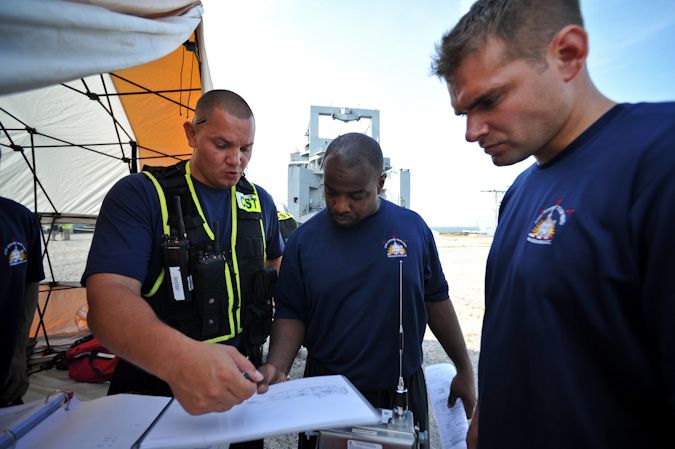
The 33rd CST receives a briefing from 1st Lt. Alex Desir, survey team leader. “Does everyone remember that entry door at the bow of the ship that goes down to the bow thruster? According to the intel they [fire department] gave me that’s where they [fire department] got their initial reading.”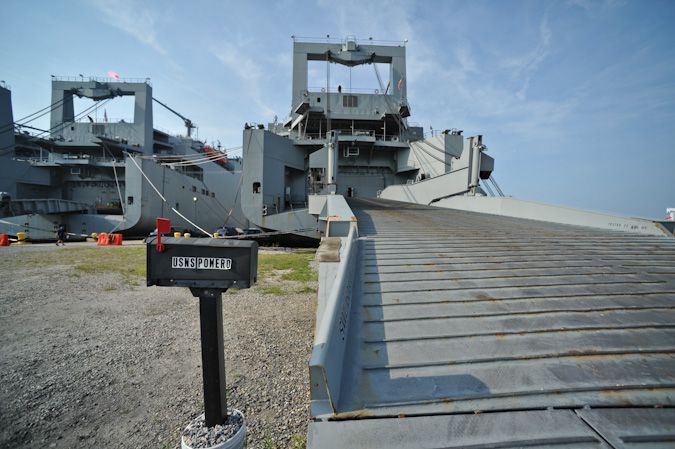 The scenario took place aboard the U.S. Naval Ship Pomeroy, a large, medium-speed roll-on/roll-off ship under the Military Sealift Command. The ship is named after Pfc. Ralph E. Pomeroy, from Quinwood W.Va., who was killed in Korea Oct. 15, 1952, and posthumously awarded the Medal of Honor.
The scenario took place aboard the U.S. Naval Ship Pomeroy, a large, medium-speed roll-on/roll-off ship under the Military Sealift Command. The ship is named after Pfc. Ralph E. Pomeroy, from Quinwood W.Va., who was killed in Korea Oct. 15, 1952, and posthumously awarded the Medal of Honor.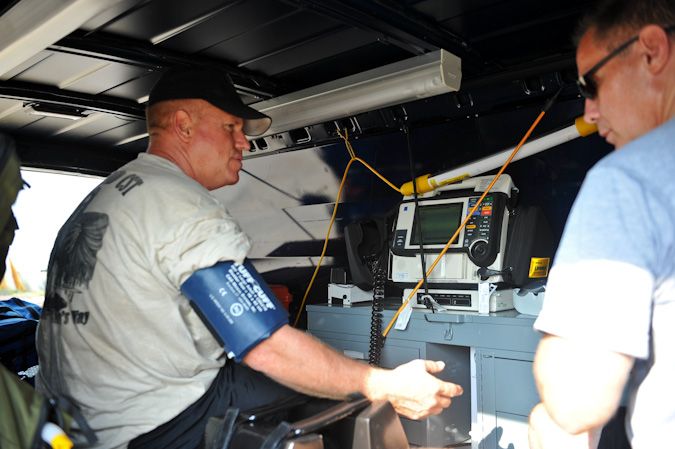
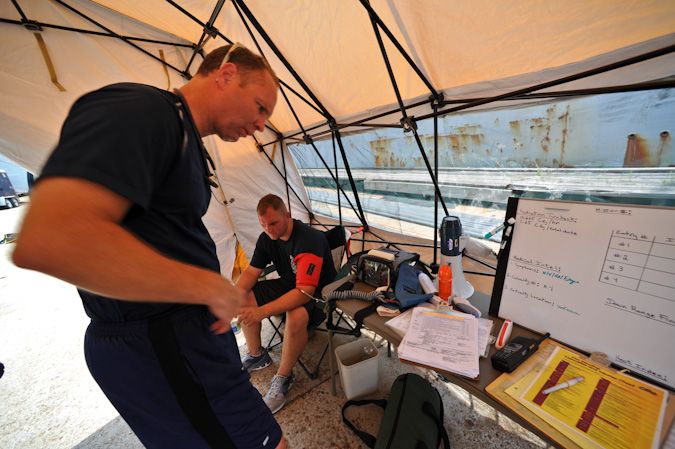 The physician assistant gets baseline health readings before each team member suits up. Each team member must be fit to perform the mission at hand. The protective suits make the wearer hotter, increasing the amount of sweat, heart rate, etc.
The physician assistant gets baseline health readings before each team member suits up. Each team member must be fit to perform the mission at hand. The protective suits make the wearer hotter, increasing the amount of sweat, heart rate, etc.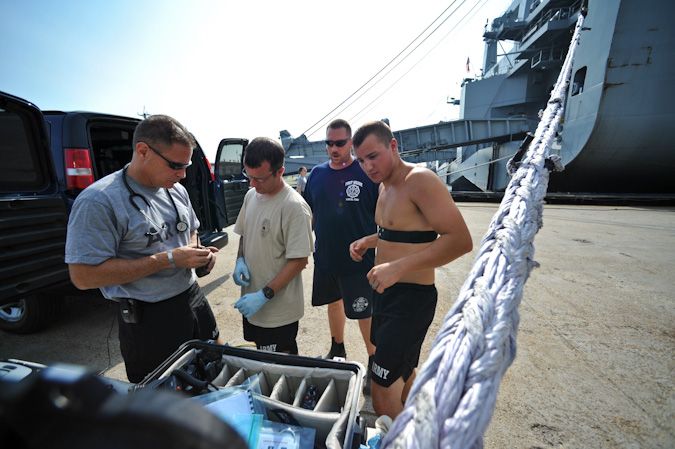 Primaries and backups who suit up and go down range go through a health screening before and after the mission. Entry teams are fitted with a Zephyr BioHarness which monitors the vitals of the team members while down range performing their duties.
Primaries and backups who suit up and go down range go through a health screening before and after the mission. Entry teams are fitted with a Zephyr BioHarness which monitors the vitals of the team members while down range performing their duties.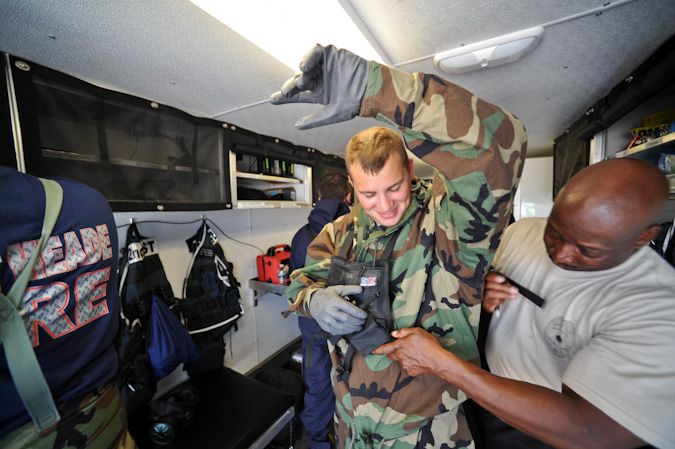
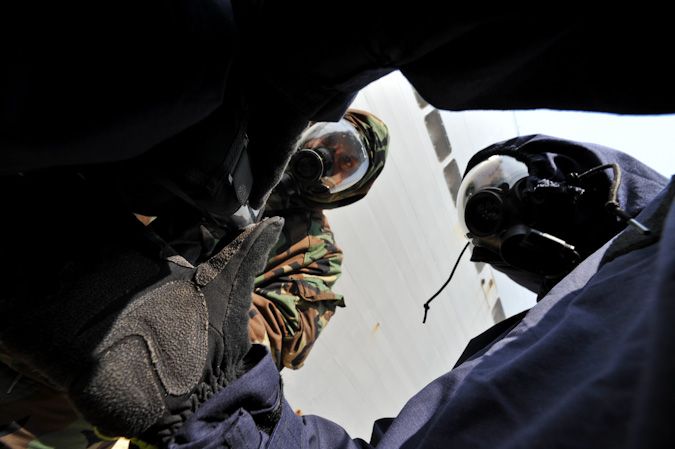 Team members don Mission Oriented Protective Posture Level 4 or MOPP 4 or the Joint Service Lightweight Integrated Suit Technology or JSLIST to carry out this mission. The proper wear of this equipment is vital for completing the mission safely. Team members constantly monitor each other and correct malfunctions.
Team members don Mission Oriented Protective Posture Level 4 or MOPP 4 or the Joint Service Lightweight Integrated Suit Technology or JSLIST to carry out this mission. The proper wear of this equipment is vital for completing the mission safely. Team members constantly monitor each other and correct malfunctions.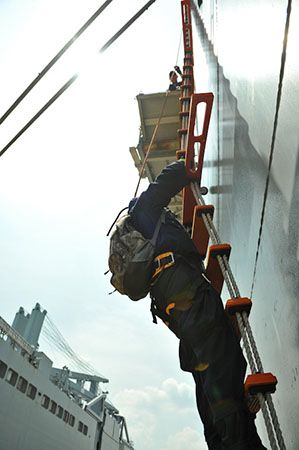
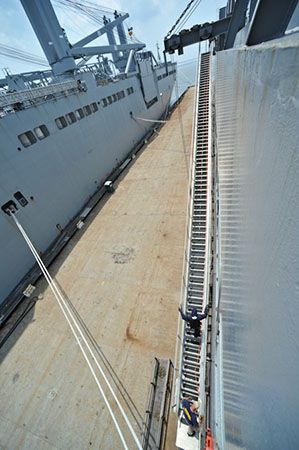 Entry teams had to climb this more than 30-foot Jacob’s ladder, a biblical reference for the ladder to heaven, and up a lowered staircase to board the ship. The teams had to search the entire 950-foot cargo ship for the type and source of radiation.
Entry teams had to climb this more than 30-foot Jacob’s ladder, a biblical reference for the ladder to heaven, and up a lowered staircase to board the ship. The teams had to search the entire 950-foot cargo ship for the type and source of radiation.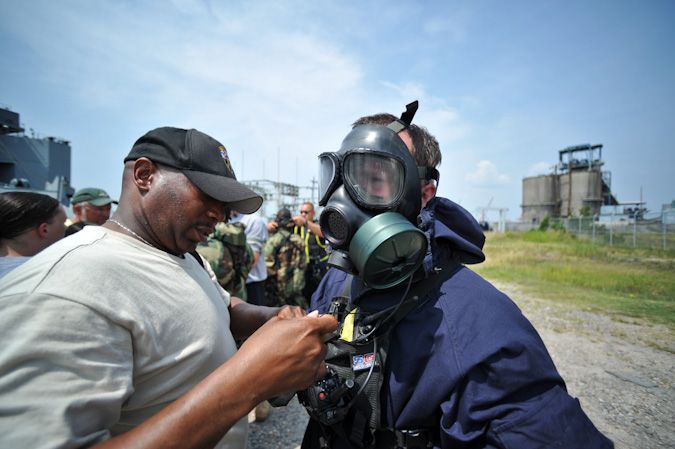 When asked how the conditions were on the ship, Spc. John Manning replied, “Hot, very hot. There were a lot of confined spaces we had to move through. The cargo bays were giant open areas, but a lot of the stairwells we were in were really tight. We had to watch our heads as not to hit anything.”
When asked how the conditions were on the ship, Spc. John Manning replied, “Hot, very hot. There were a lot of confined spaces we had to move through. The cargo bays were giant open areas, but a lot of the stairwells we were in were really tight. We had to watch our heads as not to hit anything.”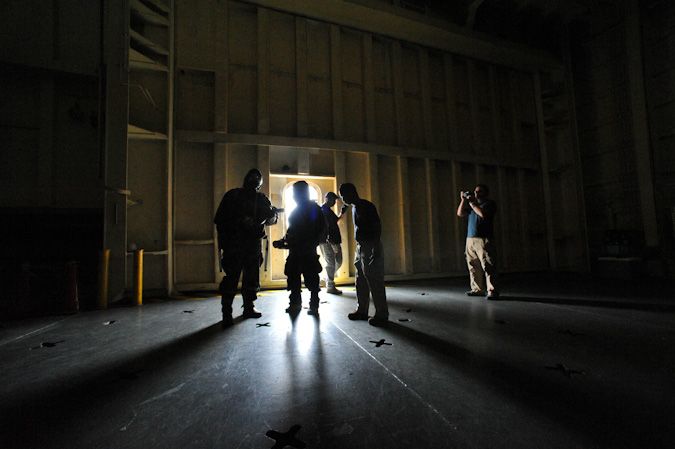 The teams detected two spectra cesium 137, a radioactive isotope that is a nuclear fission byproduct, and barium 133, a silvery earth metal, in the bow thruster room as well as two improvised explosive devices, neutralized of by an explosive ordnance disposal team.
The teams detected two spectra cesium 137, a radioactive isotope that is a nuclear fission byproduct, and barium 133, a silvery earth metal, in the bow thruster room as well as two improvised explosive devices, neutralized of by an explosive ordnance disposal team.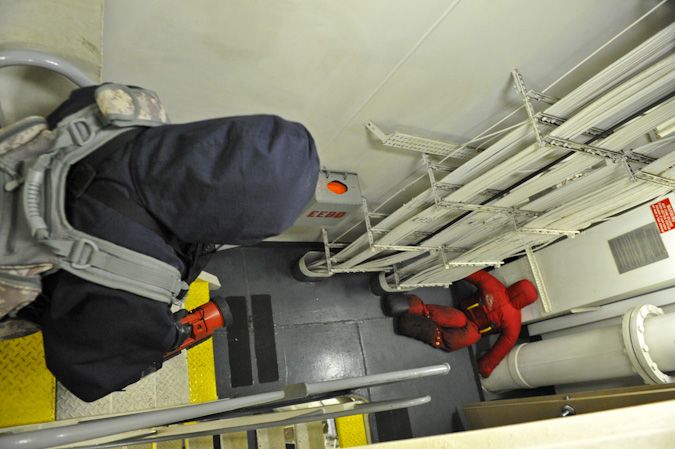 In the engine room toward the stern of the ship, the teams found another IED along with confirmed gamma radiation readings.
In the engine room toward the stern of the ship, the teams found another IED along with confirmed gamma radiation readings.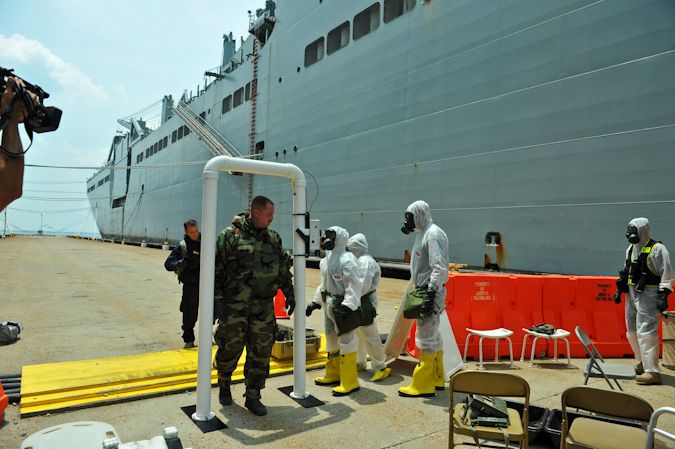 Returning from the mission team members cross the hotline. The area before the hotline is the hot zone, or contaminated area. Crossing the hotline is the warm zone, or the decontamination process. After the warm zone is the cold zone, or the area free of contamination.Team members dropped their equipment off and walked through the portal monitor, which scans for gamma contamination. The portal monitor is best used for screening large numbers of people.
Returning from the mission team members cross the hotline. The area before the hotline is the hot zone, or contaminated area. Crossing the hotline is the warm zone, or the decontamination process. After the warm zone is the cold zone, or the area free of contamination.Team members dropped their equipment off and walked through the portal monitor, which scans for gamma contamination. The portal monitor is best used for screening large numbers of people.
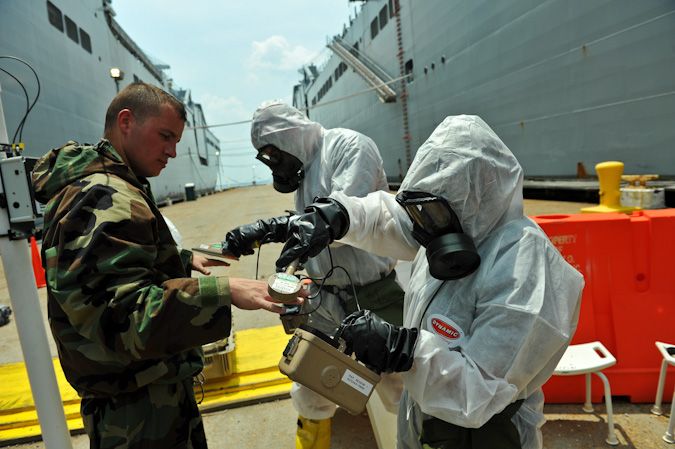
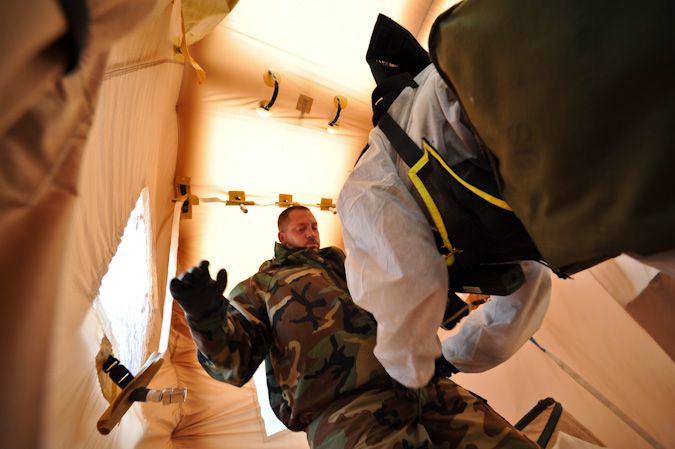 Probes are used to check for alpha and beta radiation on the hands and feet. If clean, the team member steps onto a huge bag to remove protective gear, sealing up the bag afterward. Normally their mask would still be on, but during this exercise, they were allowed to remove it once off the ship.
Probes are used to check for alpha and beta radiation on the hands and feet. If clean, the team member steps onto a huge bag to remove protective gear, sealing up the bag afterward. Normally their mask would still be on, but during this exercise, they were allowed to remove it once off the ship.
“Maritime operations are important to conduct especially for Maryland because of the Port of Baltimore and the fact that we border the Atlantic Ocean,” said Maj. Andrew Collins, deputy commander of 32nd CST. “It was a small training gap we had that we needed to get a lot more training on and Operation Cold Steel was able to provide that to us.”

